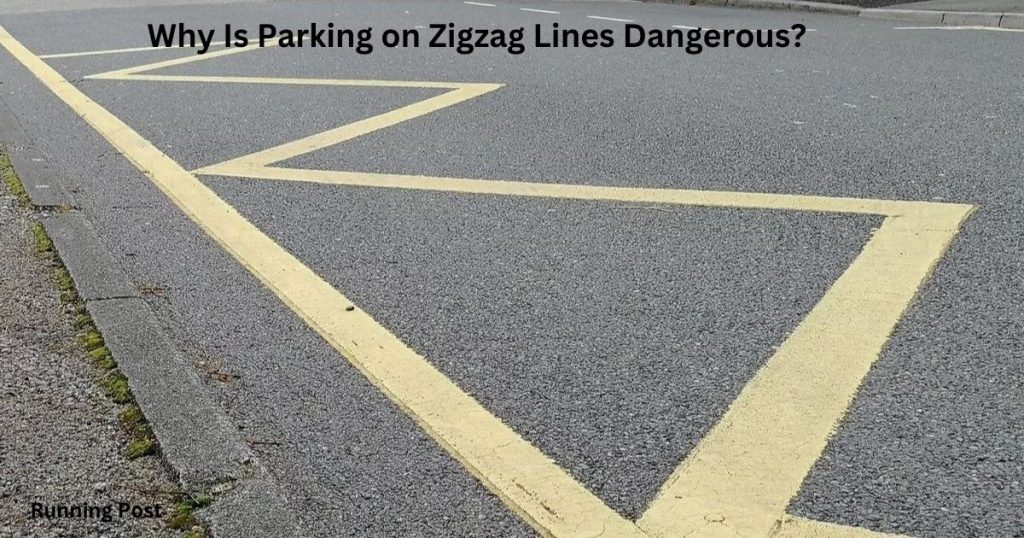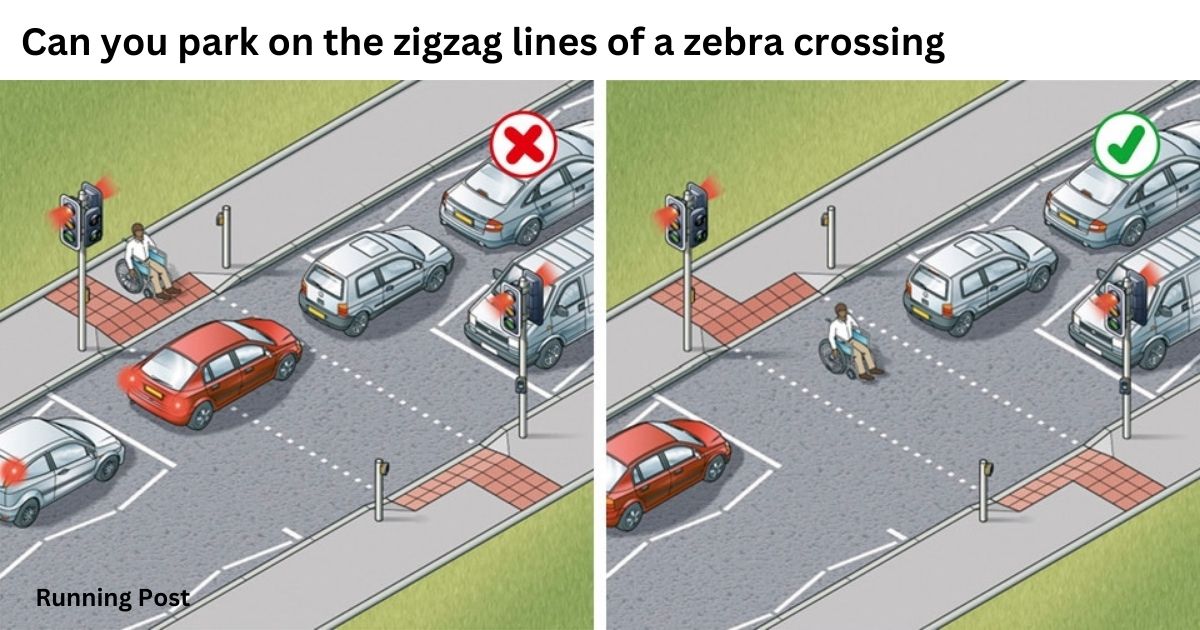| A: No, not under any circumstances | B: Yes, in order to drop off a passenger | C: Yes, if you don’t block people from crossing | D: No, unless you stay with your car |
Understand The Can you park on the zigzag lines of a zebra crossing when there are no other parking spaces to be found?
Introduction
Understanding the parking rules near zebra crossings is crucial for every driver. Zebra crossings are pedestrian-priority zones that ensure the safety of individuals crossing the road. Many drivers often find themselves in situations where they are tempted to park on the zigzag lines of a zebra crossing due to a lack of parking spaces. However, knowing the rules and regulations about parking near zebra crossings is vital to avoid legal consequences and ensure road safety. This blog post will explore whether it’s permissible to park on the zigzag lines of a zebra crossing, the meaning and purpose of these lines, the potential dangers, and what drivers should do when parking spaces are scarce.
Can You Park on Zigzag Lines on a Zebra Crossing?
Parking on zigzag lines near a zebra crossing is a strict no-go. These lines are not just there for decoration; they serve a specific and critical function. Parking on them, even for a short time, is illegal and can lead to severe penalties. Zigzag lines are designed to ensure clear visibility for both drivers and pedestrians, helping to prevent accidents. Blocking this area with a parked vehicle can obscure pedestrians and increase the likelihood of collisions. Thus, regardless of how scarce parking spaces might be, parking on these lines is never justified.
Quick Answer: No, Not Under Any Circumstances
The quick and straightforward answer to whether you can park on the zigzag lines of a zebra crossing is a resounding “No.” The rules are clear and absolute: parking on zigzag lines is not allowed under any circumstances. These lines are there to protect pedestrians by maintaining a clear view for approaching drivers. Stopping or parking on them disrupts this safety mechanism and creates a hazard.
Legal Implications of Parking on Zigzag Lines
Parking on zigzag lines can result in hefty fines and penalties. These penalties are in place to deter drivers from obstructing pedestrian crossings and compromising road safety. Depending on the jurisdiction, you could face a fine, penalty points on your driving license, or even towing of your vehicle. The legal framework is designed to ensure that zebra crossings remain clear of any obstruction to safeguard pedestrians.
What is the Zigzag Line at the Zebra Crossing?
Zigzag lines are road markings that appear before and after a zebra crossing. They serve to alert drivers to the presence of a crossing ahead and to enforce a no-parking zone around the crossing. The zigzag lines prevent cars from parking too close to the crossing, which would obstruct the view of pedestrians and drivers alike. These markings are a universal road safety feature used worldwide to enhance pedestrian safety at crossings.
Definition and Purpose of Zigzag Lines
Zigzag lines serve two main purposes: warning and restriction. They warn drivers of an upcoming pedestrian crossing and restrict any stopping or parking near the crossing. This is to ensure that drivers have a clear line of sight of pedestrians intending to cross and that pedestrians are visible to oncoming traffic. The markings are part of a broader set of road safety measures to minimize accidents at pedestrian crossings.
Differences Between Zigzag Lines and Other Road Markings
Unlike other road markings, such as double yellow lines or dashed white lines, zigzag lines specifically indicate a pedestrian crossing area. Double yellow lines usually signify a no-parking area, but vehicles can still stop briefly for loading or unloading. Zigzag lines, however, prohibit any stopping or parking whatsoever. The rules governing zigzag lines are much stricter due to the potential risk to pedestrian safety.
What Does the Zigzag Line on the Road Mean?
The zigzag line on the road signifies a high-alert area for both drivers and pedestrians. It is a visual cue that indicates the presence of a pedestrian crossing and signals to drivers that they must slow down and be prepared to stop if necessary. The zigzag lines are placed to enhance safety by ensuring that the crossing is free of obstructions that could hide a pedestrian from a driver’s view.
Significance of Zigzag Lines for Pedestrian Safety
Zigzag lines play a critical role in pedestrian safety by ensuring a clear field of vision. They are strategically placed to keep areas near the crossing free from parked cars, which could block a driver’s view of pedestrians. This is particularly important in areas with heavy foot traffic or near schools, where pedestrian movement is unpredictable.
Rules and Regulations Governing Zigzag Lines
The rules and regulations surrounding zigzag lines are designed to enforce pedestrian safety. In most jurisdictions, stopping, parking, or even overtaking on zigzag lines is strictly prohibited. These rules are enforced through fines, penalty points, and in some cases, vehicle towing. The strict enforcement of these rules highlights the importance placed on pedestrian safety over driver convenience.
Why Zigzag Lines Prohibit Stopping and Parking
Zigzag lines prohibit stopping and parking to maintain a clear and safe crossing area for pedestrians. By keeping this area free from vehicles, drivers can better see pedestrians waiting to cross, and pedestrians have a clear view of oncoming traffic. This unobstructed visibility is vital for preventing accidents and ensuring safe crossing.
How Close to a Zebra Crossing Can You Park?
Parking too close to a zebra crossing is not only illegal but also highly dangerous. Regulations specify a minimum distance from a zebra crossing where parking is permitted. This distance is enforced to keep the crossing and surrounding area clear, ensuring that drivers can see pedestrians and vice versa.
Regulations on Parking Near Zebra Crossings
Regulations typically dictate that drivers must not park within a certain distance of a zebra crossing, often marked by the zigzag lines themselves. These rules are in place to prevent cars from blocking sightlines and to maintain the safety of both pedestrians and drivers. Failing to comply with these regulations can result in fines, points on your license, or even vehicle impoundment.
Recommended Safe Distance from a Zebra Crossing
The recommended safe distance to park from a zebra crossing varies depending on local laws, but generally, it’s advised to park at least 15-30 feet away. This distance ensures that both drivers and pedestrians have a clear line of sight and that the crossing area is unobstructed. Adhering to this guideline not only helps avoid penalties but also contributes to road safety.
Consequences of Parking Too Close
Parking too close to a zebra crossing can result in several consequences, including fines, penalty points, and even accidents. Vehicles parked near crossings can obstruct the view, making it difficult for drivers to see pedestrians and for pedestrians to judge approaching traffic. This can lead to serious accidents, making it crucial for drivers to adhere to parking regulations.
Why Is Parking on Zigzag Lines Dangerous?

Parking on zigzag lines creates a dangerous situation for both drivers and pedestrians. It blocks sightlines, increases the risk of accidents, and creates confusion on the road. Drivers who park on these lines are not only breaking the law but also endangering themselves and others.
Obstruction of Pedestrian and Driver Visibility
When a vehicle is parked on zigzag lines, it obstructs the visibility of both pedestrians and drivers. This can make it difficult for drivers to see pedestrians about to cross and for pedestrians to see oncoming vehicles. Such obstructions can easily lead to accidents, especially in high-traffic areas or during peak hours.
Increased Risk of Accidents and Traffic Incidents
The presence of parked vehicles on zigzag lines can significantly increase the risk of accidents. Drivers may not see pedestrians until it’s too late, and pedestrians may step into the path of an oncoming vehicle, assuming they are visible. These conditions create a high-risk environment that can easily result in accidents or near-misses.
Legal and Safety Risks Associated with Violations
Parking on zigzag lines not only poses a risk to safety but also carries legal risks. Violating these road rules can result in fines, points on a driving license, and increased insurance premiums. More severe cases may involve court appearances or the suspension of a driver’s license.
You Also Like It:
What’s the legal minimum depth of tread for car tyres?
Which vehicles are prohibited from using the motorway?
When do windscreen pillars cause a serious obstruction to your view?
Common Misconceptions About Parking on Zigzag Lines
There are several misconceptions about parking on zigzag lines, including beliefs that it is permissible in emergencies or that quick stops are acceptable. These misconceptions can lead to dangerous practices and increase the risk of accidents.
Myths About Emergency Situations and Zigzag Lines
One common myth is that parking on zigzag lines is acceptable in emergencies. However, even in such situations, stopping on these lines can pose a significant safety risk and is generally not permitted. Drivers should find safer alternatives away from the crossing area to handle emergencies.
Clarifying the ‘No Parking’ Rule
The “no parking” rule on zigzag lines is absolute, with no exceptions. This rule is in place to protect both pedestrians and drivers by maintaining a clear, unobstructed view of the crossing. Misunderstanding or ignoring this rule can lead to serious consequences.
What Should Drivers Do When There Are No Other Parking Spaces?
When faced with the dilemma of no available parking spaces, drivers should look for alternative options rather than parking on zigzag lines. It’s essential to prioritize safety and adhere to road rules to avoid fines and ensure a safe environment for all road users.
Alternatives to Parking on Zigzag Lines
Drivers should consider alternatives such as parking in designated lots, finding a side street, or even using a paid parking facility if no free spaces are available. These alternatives help ensure that zebra crossings remain clear and safe for pedestrians.
Safe and Legal Parking Strategies
Safe and legal parking strategies include knowing the local parking regulations, using designated parking zones, and avoiding areas marked with zigzag lines or other restrictive markings. Following these strategies helps prevent fines and ensures compliance with traffic laws.
Understanding the Importance of Compliance
Compliance with parking rules near zebra crossings is critical for maintaining road safety. Adhering to these rules shows respect for pedestrian rights and contributes to a safer driving environment for everyone. Understanding the importance of these regulations can prevent accidents and save lives.
Conclusion About Can you park on the zigzag lines of a zebra crossing when there are no other parking spaces to be found?
In conclusion, it is never acceptable to park on the zigzag lines of a zebra crossing, regardless of the circumstances. These rules are in place to ensure the safety of pedestrians and maintain clear sightlines for drivers. By understanding and adhering to these parking regulations, drivers can help create a safer road environment and avoid legal consequences.
Reiterating the Importance of Adhering to Road Rules
Road rules are designed to protect all road users, especially vulnerable pedestrians. Reiterating the importance of these rules can help drivers understand the critical role they play in road safety.
Encouraging Responsible and Safe Driving Practices
Encouraging responsible and safe driving practices, including adhering to parking rules, is essential for reducing road accidents and ensuring the safety of all road users. Being mindful of these practices benefits everyone and promotes a safer community.
You Also Like It:
Why have ‘red routes’ been introduced in major cities?
Releated Posts
MAB Instructor Certification: Your Gateway to Professional Crisis Management Leadership
In today’s fast-evolving professional environments—especially in healthcare, mental health, education, and corrections—conflict and aggression can arise without warning.…
Freewayget.com: Your Ultimate Platform for Deals, Discounts, and Digital Products
Introduction to Freewayget.com In today’s fast-paced digital world, finding reliable platforms that offer authentic discounts, deals, and digital…
Affordable & Fast Embroidery Digitizing Services in Your Area
Embroidery digitizing services provide corporations, designers, and people with brilliant embroidery-equipped designs by means of changing art work…
Introduction to hdhub4u nit
In this article, we will delve into the details of hdhub4u nit, exploring its features, benefits, and why…

















